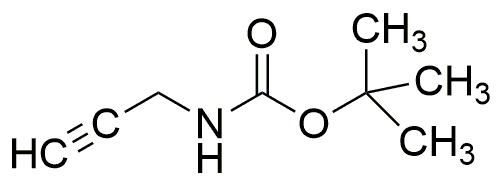N-(tert-Butoxycarbonyl)propargylamine is widely utilized in research focused on:
- Pharmaceutical Development: This compound serves as an important intermediate in the synthesis of various pharmaceuticals, particularly in the development of novel drugs targeting neurological disorders.
- Organic Synthesis: It is commonly used in organic chemistry for the preparation of more complex molecules, allowing researchers to create compounds with specific functionalities efficiently.
- Bioconjugation: The chemical is valuable in bioconjugation processes, where it helps in attaching biomolecules to surfaces or other molecules, enhancing drug delivery systems.
- Material Science: In the field of material science, it can be utilized to modify polymers, improving their properties for applications in coatings and adhesives.
- Research in Catalysis: This compound plays a role in catalytic reactions, providing researchers with a tool to explore new catalytic pathways and improve reaction efficiencies.
Informations générales
Propriétés
Sécurité et réglementation
Applications
N-(tert-Butoxycarbonyl)propargylamine is widely utilized in research focused on:
- Pharmaceutical Development: This compound serves as an important intermediate in the synthesis of various pharmaceuticals, particularly in the development of novel drugs targeting neurological disorders.
- Organic Synthesis: It is commonly used in organic chemistry for the preparation of more complex molecules, allowing researchers to create compounds with specific functionalities efficiently.
- Bioconjugation: The chemical is valuable in bioconjugation processes, where it helps in attaching biomolecules to surfaces or other molecules, enhancing drug delivery systems.
- Material Science: In the field of material science, it can be utilized to modify polymers, improving their properties for applications in coatings and adhesives.
- Research in Catalysis: This compound plays a role in catalytic reactions, providing researchers with a tool to explore new catalytic pathways and improve reaction efficiencies.
Documents
Fiches de données de sécurité (FDS)
La FDS fournit des informations de sécurité complètes sur la manipulation, le stockage et l’élimination du produit.
Spécifications du produit (PS)
Le PS fournit une description complète des propriétés du produit, notamment sa composition chimique, son état physique, sa pureté et les exigences de stockage. Il détaille également les plages de qualité acceptables et les applications prévues du produit.
Certificats d'analyse (COA)
Recherchez des certificats d'analyse (COA) en saisissant le numéro de lot du produit. Les numéros de lot et de lot se trouvent sur l'étiquette d'un produit, après les mots « Lot » ou « Lot de fabrication ».
Numéro de catalogue
Numéro de lot/série
Certificats d'origine (COO)
Ce certificat d'exploitation confirme le pays dans lequel le produit a été fabriqué, et détaille également les matériaux et composants utilisés et s'il est issu de sources naturelles, synthétiques ou autres sources spécifiques. Ce certificat peut être requis pour les douanes, le commerce et la conformité réglementaire.
Numéro de catalogue
Numéro de lot/série
Fiches de données de sécurité (FDS)
La FDS fournit des informations de sécurité complètes sur la manipulation, le stockage et l’élimination du produit.
DownloadSpécifications du produit (PS)
Le PS fournit une description complète des propriétés du produit, notamment sa composition chimique, son état physique, sa pureté et les exigences de stockage. Il détaille également les plages de qualité acceptables et les applications prévues du produit.
DownloadCertificats d'analyse (COA)
Recherchez des certificats d'analyse (COA) en saisissant le numéro de lot du produit. Les numéros de lot et de lot se trouvent sur l'étiquette d'un produit, après les mots « Lot » ou « Lot de fabrication ».
Numéro de catalogue
Numéro de lot/série
Certificats d'origine (COO)
Ce certificat d'exploitation confirme le pays dans lequel le produit a été fabriqué, et détaille également les matériaux et composants utilisés et s'il est issu de sources naturelles, synthétiques ou autres sources spécifiques. Ce certificat peut être requis pour les douanes, le commerce et la conformité réglementaire.

